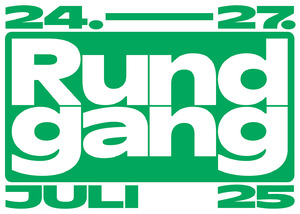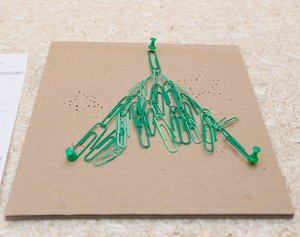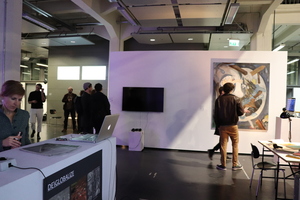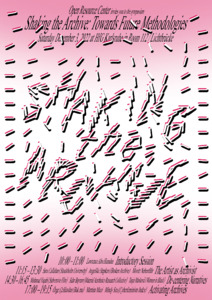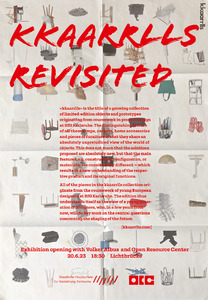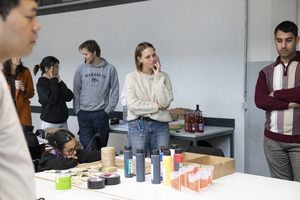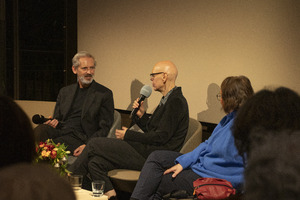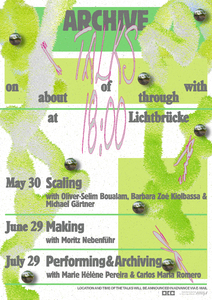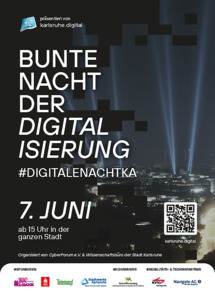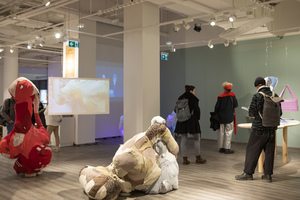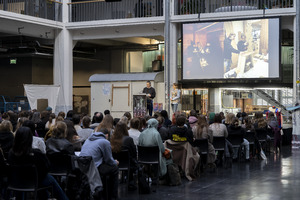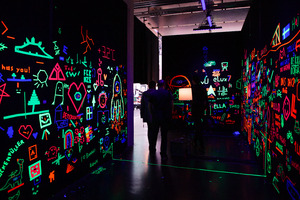Literatursalon HfG - ZKM
Benachbarte Sets (20)Alle Zusammenhänge anzeigen
Diese Sets wurden den gleichen Sets hinzugefügt wie das ausgewählte Set.
20 Inhalte
- Seite 1 von 2
Oh Tannenbaum!
- Titel
- Oh Tannenbaum!
- Titel (en)
- Oh Tannenbaum!
- Untertitel
- Designers Christmas Trees
- Beschreibung (de)
- Die Ausstellung »Oh Tannenbaum« spielt mit dem Symbol, dem allgemeinen Bild des Weihnachtsbaumes: Sie zeigt Exponate, die sich teils weit entfernt von der gängigen Vorstellung des Tannenbaums befinden und doch immer auf unterschiedlichste Art auf sie verweisen.
Der Titel der Ausstellung drückt in seiner Schreibweise sowohl die be- bis entgeisterte Betrachtung der Exponate als auch die be- bis entgeisterte gestalterische Annäherung an das Thema aus. Ob begeisternd, bestürzend oder belächelt – jedes einzelne Exponat zeugt von einem ganz eigenen Bild des jeweiligen Gestalters vom Weihnachtsbaum, das mal mehr, mal weniger mit dem allgemeinen Bild des Weihnachtsbaums korrespondiert.
Kaum ein anderes Objekt bietet hier so viel Spielraum, zeigt so viel Potential: Das Nebeneinander des einerseits so Speziellen, des eindeutigen und verbreiteten Bilds – ein in grüne Nadeln, (rote) Kugeln und (weiße) Kerzen gewandeter Kegel – und des andererseits so viel Allgemeines implizierenden Symbols macht den Weihnachtsbaum zu einem solch besonderen Objekt.
Er ist heidnisch und christlich, er steht im Super- und auf dem Weihnachtsmarkt, steht für Fruchtbarkeit und Kommerz, im Wohnzimmer und auf dem Marktplatz – in Stockholm und Kapstadt, Miami und Peking – und bietet aus verschiedensten Positionen und Blickwinkeln entsprechend unterschiedliche Gesichter.
Dass dieser Baum in all den religiösen, profankulturellen, kommerziellen, formalen, historischen, familiären, sozialen und sonstigen Böden Wurzeln schlagen konnte und aus all diesen doch zu einer so eindeutigen und unverwechselbar immergrünen Ikone wuchs, scheint den Gestaltern so viele Ansatzpunkte zu Idealisierung, Ironisierung, Kritik, Collage, Persiflage, Hinterfragung, Überzeichnung, Verballhornung oder sonstiger Gestaltung zu bieten.
Vielleicht entlocken Ihnen die Motive ja auch ein entzücktes "Oh Ja!", das ein oder andere "Oh je" und vielleicht auch so manches "Oh nein!"...
Fröhliches Betrachten!
Johannes Marmon & Johannes Müller
- Die Ausstellung »Oh Tannenbaum« spielt mit dem Symbol, dem allgemeinen Bild des Weihnachtsbaumes: Sie zeigt Exponate, die sich teils weit entfernt von der gängigen Vorstellung des Tannenbaums befinden und doch immer auf unterschiedlichste Art auf sie verweisen.
- Beschreibung (en)
- The exhibition »Oh Tannenbaum« plays with the iconic symbol of the Christmas tree. Although some of the contributions are far removed from the popular notion of what this tree looks like, each refers to the traditional image in its own way.
The unusual spelling in the title of the exhibition – “Oh” rather than the conventional “O” Tannenbaum – is intended to convey both the range of possible reactions to the works on show – from enthusiastic approval to bemused consternation – and the equally diverse creative approaches to the chosen theme. Whether it elicits a smile of amusement, an appreciative nod or a shocked gasp, each exhibit reflects its creator’s personal vision of the Christmas tree, which may or may not correspond to the standard image of this object.
Few other objects offer as much scope for interpretation or have such evocative potential as the Christmas tree. The combination of the specific and the universal is what makes it so unique – on the one hand there is the classic image of a cone-shaped object clad in green needles, (red) baubles and (white) candles, and on the other is the widespread recognition and value of this symbol.
The Christmas tree is both pagan and Christian; it can be found in supermarkets and at winter fairs; it represents fertility and commerce; it is put on display in living rooms and on public squares from Stockholm to Cape Town, Miami to Beijing – and takes on a new appearance from every different angle.
The fact that this tree has put down roots in all these different religious, secular, commercial, formal, historical, familial, social and other traditions, yet has still managed to grow into such an unmistakable evergreen icon, provides many valuable starting points for idealizing, ironic, critical, collaged, satirical, challenging, exaggerating, parodying and other individual forms of interpretation.
Now all that remains to be seen is which interpretations among those presented here will make you respond with a delighted “Oh yes!”, the occasional “Oh dear” and even the odd “Oh no!”...
Happy viewing!
Johannes Marmon & Johannes Müller
- The exhibition »Oh Tannenbaum« plays with the iconic symbol of the Christmas tree. Although some of the contributions are far removed from the popular notion of what this tree looks like, each refers to the traditional image in its own way.
- Typ des Projekts/Werks
- Datierung
- 2004 / 2013
- Ort
- Hochschule für Gestaltung
- Stadt
- Land
- Internetlinks
- Titel
- Oh Tannenbaum!
- Importiert am
- 03.07.2018
- Übergeordnete Sets
- 1
- Set enthält
- 0 45
Critical Zones: An open laboratory exhibition at HfG
- Titel
- Critical Zones: An open laboratory exhibition at HfG
- Autor/in
- Beschreibung (en)
- “Critical Zones”: Developing concepts and approaches for grasping the New Climatic Regime (Bruno Latour), that is the transformations in the relations of humans to their “terrestrial” conditions of existence. – The seminar series of Bruno Latour at HfG analyses these transformations as epistemic breaks and shifts of knowledge by drawing an analogy to the scientific revolution in the 17th century, where, after a crisis of former sound knowledge, new epistemic systems, representations and narrations in art, science, and religion had to be constructed and reintegrated into new dispositifs of knowledge. The project tackles an important aesthetic question, which overpasses simple forms of illustration of knowledge: How central is the imaginary capacity of the arts in constructing representations and narrations that are depictions and “generators” of new knowledge systems and therefore vital means of cultural change?
The exhibition at HfG in November will display some preliminary results of the projects developed by the seminar participants. It presents an opportunity to discuss – in a mode of work-in-progress – research questions, aesthetic approaches and epistemic experiments with colleagues and students of HfG and ZKM.
Opening: Nov 7, 19:00; duration: Nov 8, 10:00-19:00, Nov 9, 10:00-15:00
HfG, mittlere Lichtbrücke
- “Critical Zones”: Developing concepts and approaches for grasping the New Climatic Regime (Bruno Latour), that is the transformations in the relations of humans to their “terrestrial” conditions of existence. – The seminar series of Bruno Latour at HfG analyses these transformations as epistemic breaks and shifts of knowledge by drawing an analogy to the scientific revolution in the 17th century, where, after a crisis of former sound knowledge, new epistemic systems, representations and narrations in art, science, and religion had to be constructed and reintegrated into new dispositifs of knowledge. The project tackles an important aesthetic question, which overpasses simple forms of illustration of knowledge: How central is the imaginary capacity of the arts in constructing representations and narrations that are depictions and “generators” of new knowledge systems and therefore vital means of cultural change?
- Typ des Projekts/Werks
- Schlagworte
- Datierung
- 07.11.2018 - 09.11.2018
- Mitwirkende
- Ort
- Hochschule für Gestaltung Karlsruhe
- Stadt
- Land
- Beteiligte Institution(en)
- Titel
- Critical Zones: An open laboratory exhibition at HfG
- Projektleiter/in
- Semester
- Importiert am
- 17.01.2019
- Übergeordnete Sets
- 1
- Set enthält
- 0 8
Shaking the Archive
- Titel
- Shaking the Archive
- Titel (en)
- Shaking the Archive
- Autor/in
- Beschreibung (de)
- “…however we define archives, they have no meaning outside the subjective experience of those individuals who, at a given moment, come to use them…” / “On the one hand, there is no state without archives - without its archives. On the other hand, the very existence of the archive constitutes a constant threat to the state.”
Achille Mbembe, The Power of the Archive and its Limits
Weltweit entstehen immer mehr „marginale“, „laterale" oder nicht-institutionelle, selbstinitiierte, informelle und kleine private Archive, die von der Politik öffentlicher Institutionen hinterlassene Lücken schließen und marginalisierten Personen und Realitäten eine Stimme geben. Dabei handelt es sich oft nicht um Archive im eigentlichen Sinne, sondern um Indizes oder kreative Projekte, die mit Materialien und Daten auf neuartige Weise umgehen. Parallel dazu und in Verbindung damit ist eine große Anzahl von forschungsbasierten kreativen Praktiken entstanden, die mit der Aneignung und Neuformulierung archivarischer Methoden arbeiten und damit auf eine Medienrealität im beschleunigten Wandel reagieren. Das Internet und die neuen Medien fordern dazu heraus, neue Sprachen und Methoden des Archivierens zu entwickeln, aber auch eine politisch-strategische, interdisziplinäre Debatte darüber zu führen, was es wirklich bedeutet, Archivmaterial zu teilen beziehungsweise zu kommerzialisieren. Die oben genannten Phänomene: subalterne Archive, forschungsbasierte künstlerische Praktiken und das Aufkommen neuer Medien erschüttern das Archiv – sowohl Inhalt als auch formal – auf unterschiedliche Weise. Gerade der Blick auf kleine und marginale Archivierungsinitiativen lässt uns die heutigen Herausforderungen im Feld der Archive verstehen: das kontinuierliche Aufzeichnen von Ereignissen, das dynamische und autonome Verwalten von Daten, das Dokumentieren und Bewahren möglichst aller Stimmen.
Das Thema des 30-jährigen Jubiläums der HfG Karlsruhe ist "The future of“. Die Zukunft können wir nicht gestalten, ohne uns den gegenwärtigen Fragen der Archivierung des Vergangenen zu stellen. Um unsere Sicht auf die Realität, auf konventionelle westliche Formen des Wissens, der Klassifizierung und der Bewertung in Frage zu stellen, um die jüngste Vergangenheit und ihre materiellen und „immateriellen“ Veränderungen zu dokumentieren, um die vielfältigen und miteinander verknüpften Dringlichkeiten der Gegenwart anzugehen, brauchen wir sowohl das Archiv als auch seine Erschütterungen. Anstatt den Begriff des Fortschritts in Bezug auf die Zukunft allgemein und insbesondere auf die Zukunft des Archivierens zu verwenden, möchten wir die Dimension der Zukunft unter dem Aspekt des Potenzials untersuchen.
Gastredner*innen sind u. a. der Künstler Lawrence Abu Hamdan, die Begründerin des Cyberfeminism Index Mindy Seu, die Direktorin der Villa Romana in Florenz Angelika Stepken und die Wissenschaftlerin Özge Çelikaslan.
- “…however we define archives, they have no meaning outside the subjective experience of those individuals who, at a given moment, come to use them…” / “On the one hand, there is no state without archives - without its archives. On the other hand, the very existence of the archive constitutes a constant threat to the state.”
- Beschreibung (en)
- “…however we define archives, they have no meaning outside the subjective experience of those individuals who, at a given moment, come to use them…” / “On the one hand, there is no state without archives - without its archives. On the other hand, the very existence of the archive constitutes a constant threat to the state.”
Achille Mbembe, The Power of the Archive and its Limits
'Marginal/Lateral’ or non-institutional, self-initiated, informal and small private archives are cropping up across the globe to address gaps and offer a voice to marginalized bodies and realities. These are often not archives in the strict sense of the word, but come in the form of indexes or creative projects that reframe materials and data. Both in parallel and in conjunction, an unprecedented number of research based creative practices, which use appropriation and re-framing (by drawing from the archive or building it) as the basis for their work, and to make sense of a rapidly changing mediatic reality, have also emerged. The added context of the internet and the birth of new media have created the urgency to create a new language and method of archiving, as well for an ethical debate, across different disciplines, around what it really means to share (and often commodify) archival materials. The above fields of enquiry: subaltern archives, research based artistic practices and the emergence of new media are all shaking the archive—both in terms of content and container—in different ways. In order to re-shape our ways of keeping a dynamic record, of sorting and storing data, of preserving all voices, we cannot ignore small scale archival initiatives and attempts.
The theme of HfG’s 30 year anniversary is “the future of” and a future cannot be consciously built without facing a new set of questions around archiving present and past. In order to upend our learned assumptions about reality, about Western forms of knowledge, classification and value; in order to keep a record of the recent past and its material and immaterial transformations; in order to address the multiple, yet interconnected urgencies of the present, we need both the archive and the question, and neither of these ingredients can ever be static. Rather than adopting a notion of progress in relation to the future in general and the future of archiving more specifically, we would like to explore the idea of the future within the framework of potential.
Guests include artist Lawrence Abu Hamdan, Cyberfeminism Index Founder, Mindy Seu, director of Villa Romana in Florence, Angelika Stepken, researcher, Özge Çelikaslan and more.
- “…however we define archives, they have no meaning outside the subjective experience of those individuals who, at a given moment, come to use them…” / “On the one hand, there is no state without archives - without its archives. On the other hand, the very existence of the archive constitutes a constant threat to the state.”
- Typ des Projekts/Werks
- Schlagworte
- Datierung
- 03.12.2022
- Mitwirkende
- Sprache
- Material
- Ort: Institution
- Stadt
- Land
- Bemerkungen
- Titel
- Shaking the Archive
- Semester
- Importiert am
- 01.03.2023
- Übergeordnete Sets
- 1
- Set enthält
- 0 1
kkaarrlls revisited
- Titel
- kkaarrlls revisited
- Autor/in
- Beschreibung (de)
- Das HfG OPEN RESOURCE CENTER lädt Sie herzlich ein zur Eröffnung der Ausstellung kkaarrlls Revisited
Dienstag
20. Juni
18:30
Lichtbrücke
Volker Albus, einer der dienstältesten Professoren des Fachbereichs Produktdesign und ehemaliger Prorektor der HfG, eröffnet die Ausstellung ausgewählter Objekte der Designmarke kkaarrlls, die von HfG-Studierenden entworfen und entwickelt wurden.
kkaarrlls ist ein Projekt, das innerhalb des Fachbereichs PD initiiert wurde und sich zu einer hauseigenen Marke der HFG Design entwickelt hat. Sie repräsentiert eine erlesene Auswahl an Arbeiten von PD-Studierenden aus dem Zeitraum von 2009 bis 2017.
kkaarrlls wurde regelmäßig auf dem Salone Internazionale del Mobile in Mailand präsentiert und hat internationale Aufmerksamkeit in Zeitungen wie Le Monde oder New York Times erlangt.
- Das HfG OPEN RESOURCE CENTER lädt Sie herzlich ein zur Eröffnung der Ausstellung kkaarrlls Revisited
- Beschreibung (en)
- The HfG OPEN RESOURCE CENTER cordially invites you to the opening of the kkaarrlls Revisited exhibition
Tuesday
20th of June
18:30
Lichtbrücke
Volker Albus, one of the longest serving professors of the Product Design department and former HfG prorektor, will open the exhibition of selected items of the kkaarrlls design brand, created and developed by HfG students.
kkaarrlls is a project initiated inside the PD department and has evolved into an in-house brand of HFG design, representing a distinguished selection of PD student's works from the period of 2009 to 2017.
kkaarrlls has been perdiodically presented at the salone internazionale del mobile in Milan and has gained international attention in newspapers like Le Monde or New York Times.
- The HfG OPEN RESOURCE CENTER cordially invites you to the opening of the kkaarrlls Revisited exhibition
- Typ des Projekts/Werks
- Schlagworte
- Datierung
- 20.06.2023
- Ort: Institution
- Ort
- Lichthof 3
- Stadt
- Land
- Internetlinks
- Titel
- kkaarrlls revisited
- Importiert am
- 26.07.2023
- Übergeordnete Sets
- 1
- Set enthält
- 0 5
PRESENT TENSE Working in Critical Times
- Titel
- PRESENT TENSE Working in Critical Times
- Titel (en)
- PRESENT TENSE Working in Critical Times
- Untertitel
- Symposium des Kunstbüros der Kunststiftung Baden-Württemberg
- Autor/in
- Beschreibung (de)
- „Present Tense” beschäftigt sich mit unserer unmittelbaren Gegenwart: Wir leben in einer komplexen, krisenhaften Zeit, in der die Überlagerung von Klima- und Energiekrise, Postpandemie, Prekarität und Konkurrenz, gesellschaftlicher Radikalisierung bis hin zu näher rückenden Kriegen bereits jetzt gravierende Auswirkungen auf unser Leben und Arbeiten hat. Die Anspannung steigt, wir stehen vor dringlichen gesamtgesellschaftlichen Aufgaben und bewegen uns zugleich in Richtung eines Zustands chronischer Erschöpfung. Das etablierte Kunstfeld und die künstlerische und kulturelle Produktion sind davon nicht ausgenommen. Mit Künstler:innen, Kurator:innen und anderen Expert:innen des kulturellen Feldes möchten wir den Blick auf die aktuelle künstlerische Produktion und Ausstellungspraxis richten und die Frage nach möglichen (Zukunfts-)perspektiven für das Kunstfeld diskutieren:
Welche gesellschaftliche Rolle können und müssen Kunst und ihre Produzent:innen in einer sich radikal verändernden Welt einnehmen? Wie können Kunst- und Kulturinstitutionen zu Orten aktiver gesellschaftlicher Transformation werden? Was bedeutet es, eine (ökologisch wie sozial) nachhaltige künstlerische und institutionelle Praxis in der digitalen Gegenwart zu entwickeln? Welche neuen Gemeinschaften brauchen wir, gerade im Hinblick auf die zunehmende gesellschaftliche Spaltung und Radikalisierung? Offensichtlich führt die krisenhafte Gegenwart u. a. dazu, dass sich Menschen nach autoritären Figuren und Programmen sehen – eine Aufgabe von Kunst und Kultur könnte es sein, andere, freiere Konzepte von Zukunft zu entwerfen.
Auch das Konzept der Fürsorge in der künstlerischen und kuratorischen Praxis wird Thema der Veranstaltung sein. Teil des Symposiums sind neben Vorträgen künstlerische Workshops, Interventionen und Performances, die wir als gleichwertige Formen der Wissensproduktion und -vermittlung begreifen.
Mit Beiträgen von Gin Bahc, Sascia Bailer, Constanze Fischbeck, Sina Hensel, Alistair Hudson, Anne Duk Hee Jordan, Valentina Karga, Matriarchale Volksküche, Jacob Ott und Dorothee Richter.
- „Present Tense” beschäftigt sich mit unserer unmittelbaren Gegenwart: Wir leben in einer komplexen, krisenhaften Zeit, in der die Überlagerung von Klima- und Energiekrise, Postpandemie, Prekarität und Konkurrenz, gesellschaftlicher Radikalisierung bis hin zu näher rückenden Kriegen bereits jetzt gravierende Auswirkungen auf unser Leben und Arbeiten hat. Die Anspannung steigt, wir stehen vor dringlichen gesamtgesellschaftlichen Aufgaben und bewegen uns zugleich in Richtung eines Zustands chronischer Erschöpfung. Das etablierte Kunstfeld und die künstlerische und kulturelle Produktion sind davon nicht ausgenommen. Mit Künstler:innen, Kurator:innen und anderen Expert:innen des kulturellen Feldes möchten wir den Blick auf die aktuelle künstlerische Produktion und Ausstellungspraxis richten und die Frage nach möglichen (Zukunfts-)perspektiven für das Kunstfeld diskutieren:
- Beschreibung (en)
- „Present Tense” concerns itself with our immediate present: We live in a complex, crisis-filled age in which the overlapping of climate and energy crisis, post-pandemic times, precarity, social radicalisation and even impending wars already govern our lives and work. Tension is rising, we are faced with imperative responsibilities for society as a whole and are, at the same time, moving towards a state of chronic exhaustion. There is no exception for the field of arts and artistic and cultural production.
Together with artists, curators and other experts from the cultural field, we would like to examine current artistic productions and exhibition practices and discuss possibilities for the (future) perspectives of the arts. Which roles within society can and must art and its producers embrace in a radically changing world? How can art and cultural institutions become venues of active social transformation? What does it mean to develop an (ecologically as well as socially) sustainable artistic and institutional practice in the digital present? The concept of care within artistic and curatorial practices will be a topic of the event as well.
What new relationships do we need, especially in view of intensifying social division and radicalisation? Obviously, the crisis-filled present among other things leads to people looking to authoritarian figures and programmes – one of the tasks for art and culture could be to design other, more independent and free concepts of the future.
In addition to lectures and panels, the symposium will include artistic workshops, interventions and performances, which are also forms of knowledge production and dissemination that we feel to be of equal importance.
With contributions from Gin Bahc, Sascia Bailer, Constanze Fischbeck, Sina Hensel, Alistair Hudson, Anne Duk Hee Jordan, Valentina Karga, Matriarchale Volksküche, Jacob Ott and Dorothee Richter
- „Present Tense” concerns itself with our immediate present: We live in a complex, crisis-filled age in which the overlapping of climate and energy crisis, post-pandemic times, precarity, social radicalisation and even impending wars already govern our lives and work. Tension is rising, we are faced with imperative responsibilities for society as a whole and are, at the same time, moving towards a state of chronic exhaustion. There is no exception for the field of arts and artistic and cultural production.
- Typ des Projekts/Werks
- Schlagworte
- Datierung
- 26.10.2023 - 28.10.2023
- Mitwirkende
- Sprache
- Ort: Institution
- Ort
- Lichthof, R.112
- Stadt
- Land
- Beteiligte Institution(en)
- Internetlinks
- Titel
- PRESENT TENSE Working in Critical Times
- Semester
- Importiert am
- 06.11.2023
- Übergeordnete Sets
- 1
- Set enthält
- 0 146
Vom Nutzen der Kunst
- Titel
- Vom Nutzen der Kunst
- Titel (en)
- On the benefits of art
- Autor/in
- Beschreibung (de)
- In der gemeinsamen Gesprächsreihe "Vom Nutzen der Kunst" von ZKM und HfG, laden wir internationale Gäste aus Philosophie, Literatur und Kunst zum offenen Austausch mit den Hochschulangehörigen, den Mitarbeitenden des ZKM und der Karlsruher Bevölkerung ein.
- Beschreibung (en)
- In the joint series of talks between ZKM and HfG, we invite international guests from the fields of philosophy, literature and art to an open exchange with members of the university, ZKM staff and the people of Karlsruhe.
- Typ des Projekts/Werks
- Schlagworte
- Datierung
- 16.11.2023
- Ort: Institution
- Ort
- Media Lounge
- Stadt
- Land
- Titel
- Vom Nutzen der Kunst
- Importiert am
- 28.11.2023
- Übergeordnete Sets
- 1
- Set enthält
- 2 0
Archive Talks
- Titel
- Archive Talks
- Titel (en)
- Archive Talks
- Autor/in
- Beschreibung (de)
- Die Reihe Archive Talks widmet sich der Diskussion und Erarbeitung eines gemeinsamen Verständnisses von, über, mit und durch Archive(n) aus einer transdisziplinären Perspektive. Als Open Resource Center möchten wir zur Entwicklung von künstlerischen Forschungsmethoden in Bezug auf archivarische Studien und Praktiken an der HfG beitragen. Parallel zur Arbeit der studentischen Hilfskräfte, die bereits begonnen haben, die Diplom- und Projektsammlungen ihrer jeweiligen Disziplinen unter der Koordination des ORC zu digitalisieren und zu katalogisieren, wird jede Folge der Serie auf einen bestimmten Aspekt der Archivarbeit fokussieren.
ARCHIVE TALKS I: DIE HERAUSFORDERUNG SCHIERER MENGE
Oliver-Selim Boualam, Barbara Zoe Kiolbassa und Michael Gärtner
Der ORC eröffnet die Serie Archive Talks mit einem Beitrag von Oliver-Selim Boualam, Barbara Zoe Kiolbassa und Michael Gärtner, die gemeinsam an der Dokumentation der documenta fifteen gearbeitet haben, einem der größten Kunstereignisse der Welt, das ein 100-tägiges Programm von Kunstereignissen und Installationen bietet, die an vielen verschiedenen Orten in der Stadt stattfinden und verschieden Live- und zeitbasierte Formate beinhalten. Die Frage ist einfach, aber komplex: Wie geht man mit einer solchen Größenordnung um? Barbara, Michael und Oliver geben Einblicke in ihre Arbeitsmethoden und Erfahrungen und diskutieren verschiedene Strategien der Dokumentation eines extrem vielfältigen und umfangreichen Kunstprogramms.
ARCHIVE TALKS II: Machen: Strategien der Selbstarchivierung
Moritz Nebenführ
29.06.
18:00
Die vom HfG Open Resource Center präsentierte transdisziplinäre Gesprächsreihe Archive Talks widmet sich der Diskussion über die Herausforderungen der Archivforschung und -praxis. Wir setzen die Reihe am 29. Juni fort mit Moritz Nebenführ als Gast, der über Strategien künstlerischer Selbstarchivierung sprechen wird.
Ausgehend von seiner Magisterarbeit und mehrjährigen Forschung sowie Ausstellungsarbeit zu dem belgischen Künstler und Kunstlehrer Jef Geys (1934–2018) spricht HfG Alumnus Moritz Nebenführ über dessen Strategien der Selbstarchivierung. Entlang des Begriffs der
‚Information‘ in seiner diskursiven Prägung durch die Konzeptkunst werden diese Strategien anhand von ausgewählten Ausgaben des Kempens Informatieblad perspektiviert. Die Zeitung veröffentlichte der Künstler ab 1971 als Alternative zu konventionellen Katalogformaten im Selbstverlag.
ARCHIVE TALKS III: Performen & Archivieren
Marie Helen Perreira & Carlos Maria Romero alias Atabey
22.07.2023
15:00
Main Stage
Die Dokumentation und Archivierung von Aufführungspraktiken ist eine Herausforderung, da das Wesen dieser Disziplinen auf einer besonderen Zeitlichkeit und der Einzigartigkeit der Erfahrung beruht. Die Dokumentation und Archivierung von Aufführungen stehen im Konflikt mit dem Wesen dieser Praxis selbst. Das Geschehen der Performance und ihre unwiederholbare Natur stehen im Widerspruch zur fixen Identität archivierter Aufzeichnungen oder Dokumente.
Im Mittelpunkt des Gesprächs steht die ambivalente Beziehung zwischen Performance und ihrer Dokumentation und Archivierung. Das transitorische Ereignis der Performance widersetzt sich seiner dokumentarischen Identifizierung und wird dennoch von dem Versprechen des Archivs angezogen, die Erinnerung an das Transitorische zu bewahren und in die Zukunft zu transportieren.
Der dritte Teil von Archive Talks widmet sich im Rahmen der HfG-Sommerausstellung “Rundgang 2023” der Reflexion des Status und der Natur von Archiven mit Hinblick auf Performance-Praktiken. Marie Helen Perreira & Carlos Maria Romero alias Atabey kommen aus einem engagierten und situierten Umfeld, in dem Archivierungsprozesse mit komplexen Zerbrechlichkeiten konfrontiert sind. Zusammen werden sie ihren Umgang mit archivarischen Herausforderungen in Bezug auf Performance-Praktiken vorstellen.
ARCHIVE TALKS IV: A Grin Without Marker
Filipa César
02.11.2023
18:00
Lichtbrücke
Zum Antritt ihrer Professur für Zeitbasierte Medien und Performance in der Fachgruppe Medienkunst an der HfG ist Filipa César zu Gast bei Archive Talks IV. César hat sich in ihrer künstlerischen Forschung und Praxis mehr als zehn Jahre lang mit den postkolonialen Filmarchiven in Guinea-Bissau beschäftigt.
Luta ca caba inda ist ein kreolischer Ausdruck und bedeutet "Der Kampf ist noch nicht vorbei". Dies ist auch der Titel eines unvollendeten Films im Filmarchiv von Guinea, der die Fertigstellung des Films, des Kampfes und schließlich auch ihres Projekts wie mit einem Fluch belegt. Sie eigneten sich den Titel und seinen Fluch für eine Reihe von Vorführungen und diskursiven Veranstaltungen an, die dazu dienten, die Inhalte des fragmentarischen Korpus zu kanalisieren und die darin enthaltenen Konflikte aufzuspüren. Mit "sie" sind hier die guineischen Filmemacher und das Publikum gemeint, die von der ersten Katalogisierung des Materials in Bissau über die Digitalisierung in Berlin bis hin zur Teilnahme an zahlreichen Vorführungen und Diskussionen an Dutzenden von Orten in den letzten vier Jahren eine Allianz bildeten. Luta ca caba inda hat sich als eine irrelevant-respektlose Kraft gezeigt, die sagt: Ich bin nicht von gestern.
César und die guineischen Filmemacher*innen wollen die Bilder der Bevölkerung zurückgeben, der sie gehören und an die sie gerichtet sind, und zwar in einem bescheidenen Prozess der Wiederherstellung der Bilder und ihrer Archivierung. Anstelle von kultureller Aneignung oder Vermarktung geht es ihnen um die Wiederbelebung der Archive, um den Aufbau eine Kine-Verwandtschaft, wie sie der guineische Revolutionär Amílcar Cabral im Sinne hatte, als er die Filme in Auftrag gab. Archive Talks lädt die HfG-Community ein, Filipa César willkommen zu heißen und darüber zu diskutieren, wie wir von der Vergangenheit lernen und verlernen können.
ARCHIVE TALKS V: Momente der Dringlichkeit und des Überschwangs
Özge Çelikaslan
26.11.2024
18:00
Lichtbrücke
Archive werden nicht immer mit staatlichen Mitteln und institutioneller Politik aufgebaut. Sie können auch aus Bewegungen oder aus der Initiative von Einzelpersonen hervorgehen. Der fragile und oftmals nomadische Zustand dieser Archive wirft viele Fragen auf, die in Momenten der Dringlichkeit und des Überschwangs behandelt werden müssen. Können ein autonomer Akt der Archivierung oder die Übernahme der Archive als Gemeingut eine Antwort auf diesen Moment sein?
An diesem Abend haben wir Dr. Özge Çelikaslan mit ihrem neu erschienenen Buch „Archiving the Commons: Looking Through the Lens of bak.ma“ (dpr-barcelona, 2024) zu Gast, die ihre gleichnamige Dissertation an der HfG Karlsruhe begonnen und an der HBK Braunschweig abgeschlossen hat. Im Mittelpunkt des Vortrags steht ihre intensive Feldforschung zu bak.ma, einem webbasierten nomadischen Videoarchiv, das in der Türkei nach den berühmten Gezi-Protesten von 2013 initiiert wurde.
„Geschichten von Archiven sind immer Geschichten von Phantomen, vom Tod, vom Verschwinden oder von der Auslöschung von etwas, von der Bewahrung dessen, was übrig bleibt, und seinem möglichen Wiederauftauchen – von den einen gefürchtet, von den anderen ersehnt“, schreibt Thomas Keenan in seinem Vorwort zu diesem Buch.
ARCHIVE TALKS VI: E-flux Index: Archiving the Present and Indexing the Arts
George MacBeth
12.02.2025 ab 17:30 Uhr
Lichtbrücke
Seit Ende der 1990er Jahre bestimmt das Internet zunehmend unseren Alltag und verändert unsere Kommunikation, die ohne Internet kaum noch zu denken ist. Der Eintritt von e-flux in die Kunstwelt geht auf diesen Moment des „coming online“ in den späten 1990er Jahren zurück, zunächst als Plattform für die Verbreitung von Pressemitteilungen einer kuratierten Liste von Institutionen, Museen und Galerien, später als eigener Verlag - mit e-flux Journal (gegründet 2004) und e-flux Books.
Die kuratorischen und publizistischen Aktivitäten von e-flux.com haben sich seither in unzählige Richtungen verzweigt, vermitteln Diskussionen sowohl on- als auch offline und helfen, kritische Trends in Kunst und Theorie zu verfolgen und sogar zu etablieren. Inzwischen gibt es sechs regelmäßig erscheinende Publikationsreihen: e-flux journal, e-flux Architecture, e-flux Notes, e-flux Film Notes, e-flux Criticism und e-flux Education.
Beim digitalen Publizieren in diesem Umfang stellt sich die Frage, wie mit einer solchen Masse an Informationen umzugehen ist. Wie kann man die Publikationen strukturieren und dabei Parallelen zwischen den aktuellen Diskussionen in den Bereichen Kunstkritik, Architektur und Design sowie Philosophie aufzeigen?
e-flux Index ist ein Versuch, diese Frage zu beantworten. Beim Index handelt sich um eine neue vierteljährlich erscheinende Printpublikation mit dem Auftrag, die chaotischen Ströme der gegenwärtigen Diskurse zu entwirren. In jeder Ausgabe werden in Auftrag gegebene Essays, Rezensionen und Artikel aus den fünf verschiedenen e-flux-Rubriken unter neuen Fragestellungen kombiniert. Die gedruckte Ausgabe des Index erscheint nun in ihrer fünften Ausgabe und ist in ausgewählten Kunst- und Designbuchhandlungen sowie in Museen in Kanada, Ostasien, Europa, Nordamerika und dem Vereinigten Königreich erhältlich.
In dieser Veranstaltung wird der Herausgeber des e-flux Index, George MacBeth (HfG), die redaktionelle und archivarische Logik hinter diesem neuen Publikationsprojekt darstellen und aufzeigen, wie es sich in einen breiteren Kontext archivarischer Aktivitäten im Kunstbereich einfügt.
- Die Reihe Archive Talks widmet sich der Diskussion und Erarbeitung eines gemeinsamen Verständnisses von, über, mit und durch Archive(n) aus einer transdisziplinären Perspektive. Als Open Resource Center möchten wir zur Entwicklung von künstlerischen Forschungsmethoden in Bezug auf archivarische Studien und Praktiken an der HfG beitragen. Parallel zur Arbeit der studentischen Hilfskräfte, die bereits begonnen haben, die Diplom- und Projektsammlungen ihrer jeweiligen Disziplinen unter der Koordination des ORC zu digitalisieren und zu katalogisieren, wird jede Folge der Serie auf einen bestimmten Aspekt der Archivarbeit fokussieren.
- Beschreibung (en)
- Archive Talks is a series dedicated to discussing, unlearning and envisioning common understanding on, about, with and through archives from a transdisciplinary perspective. As Open Resource Center we aim to contribute to the development of artistic research methodologies in relation to archival studies and practices at HfG. Running parallel to the work of the student assistants who already started to digitize and catalog the diploma and project collections of their corresponding departments under ORC coordination, every session will focus on a particular aspect of archival work.
ARCHIVE TALKS I: THE CHALLENGE OF SCALE
Oliver-Selim Boualam, Barbara Zoé Kiolbassa and Michael Gärtner
ORC kicks off Archive Talks with Oliver-Selim Boualam, Barbara Zoé Kiolbassa and Michael Gärtner who worked together on the documentation of documenta fifteen, one of the biggest art events of the world, offering a 100-day art events and installations program taking place in many different locations throughout the city and including many live and time-based formats. The question is simple but complex: how to deal with such a scale? Barbara, Michael and Oliver will give insight into their working methods and experiences and discuss various strategies for documenting such an extremely diverse and extensive art program.
ARCHIVE TALKS II: Making: Strategies of Self-Archiving
Moritz Nebenführ
Presented by the HfG Open Resource Center, the Archive Talks series is dedicated to discussing, unlearning and envisioning common understanding on, about, with and through archives from a transdisciplinary perspective. We continue the series on June 29 with guest Moritz Nebenführ, who will talk about artistic strategies of self-archiving.
Drawing on his master thesis and several years of research and curatorial work on the Belgian artist and art educator Jef Geys (1934-2018), HfG alumnus Moritz Nebenführ will discuss Geys' strategies of self-archiving and present close readings of selected issues of the Kempens Informatieblad, a newspaper the artist self-published beginning in 1971 as an alternative to conventional catalogue formats.
ARCHIVE TALKS III: Performing & Archiving
Marie Helen Perreira & Carlos Maria Romero aka Atabey
Documenting and archiving performance practices is a challenge since the essence of these disciplines is based on a particular temporality and the uniqueness of the experience itself. Documenting and archiving performance enters in conflict with the very nature of this practice. The happening of the performance and its unrepeatable nature oppose the fixed identity of the archival record or document.
The conversation will focus on the ambivalent relationship between performance and its documentation and archiving. The transitory event of performance resists its documentary identification and yet is attracted by the archive's promise to preserve the memory of the transitory and transport it into the future.
In its third edition on the occasion of HfG’s summer exhibition “Rundgang 2023”, Archive Talks is dedicated to reflecting the state and nature of archives with regard to performance practices. Coming from engaged and situated backgrounds, where archiving occurs in complex fragilities, Marie Helen Perreira & Carlos Maria Romero aka Atabey will present their approach to dealing with archival challenges around performance practices.
ARCHIVE TALKS IV: A Grin Without Marker
Filipa César
Welcoming her professorship of Time Based Media and Performance at HfG’s Media Art department, Archive Talks IV hosts Filipa César, focusing on her decade long artistic research and practice on the post-colonial film archives at Guinea-Bissau.
Luta ca caba inda is a Creole expression which means “The struggle is not over yet”. It is also the title of an unfinished film in a Guinean film archive, thus cursing the accomplishment of the film, of the struggle for decolonisation, and eventually of their project, too. They appropriated the title and its curse for a series of screenings and dialogues aiming at channelling the contents of the fragmentary corpus and welcoming its conflicts. “They” here means the Guinean filmmakers and the crowd that built an alliance from the first cataloguing of the materials in Bissau, through the digitisation in Berlin, up to the participation in multiple screenings and discussions in dozens of locations during the past four years. Luta ca caba inda has shown itself as an irrelevant irreverent force that claims: I am not from yesterday.
In a humble process of restitution of the images and their archiving, César and the Guinean filmmakers aim to give the images back to their people. Instead of cultural appropriation or commodification through the art market, they are dedicated to the revitalization of the archives in order to build cine-kinship, as Guinean revolutionary Amílcar Cabral had in prospect when he commissioned these films. Archive Talks invites the HfG community to welcome Filipa Cesar and to discuss together how to learn and unlearn from the past.
ARCHIVE TALKS V: Moments of Urgency and Euphory
Özge Çelikaslan
Archives are not always established with state funding and institutional policy. They can also emerge from movements or from the initiative of individuals. The fragile and often nomadic state of these archives raises many questions that need to be addressed in moments of urgency and euphory. Can an autonomous act of archiving or the adoption of the archives as commons be an answer to this moment?
On this evening we have Dr. Özge Çelikaslan as our guest with her newly published book "Archiving the Commons: Looking Through the Lens of bak.ma" (dpr-barcelona, 2024), who began her dissertation of the same title at the HfG Karlsruhe and completed it at the HBK Braunschweig. The lecture will focus on her intensive field research on bak.ma, a web-based nomadic video archive that was initiated in Turkey after the famous Gezi protests of 2013.
“Stories of archives are always stories of phantoms, of the death or disappearances or erasure of something, the preservation of what remains, and its possible reappearance—feared by some, desired by others,” writes Thomas Keenan in his foreword to the book.
ARCHIVE TALKS VI: E-flux Index: Archiving the Present and Indexing the Arts
George MacBeth
Since the late 1990s, the Internet has increasingly dominated our everyday lives and restructured how we communicate with one another. Today it’s almost impossible to think without it. The entrance of e-flux to the art world also dates back to this moment of “coming online” in the late 1990s, first as a platform for distributing press releases from a curated list of institutions, museums, and galleries, and later as a publisher in its own right—through the e-flux Journal (established in 2004) and e-flux Books.
The curatorial and publishing activities of e-flux.com have since branched out in innumerable directions, mediating discussions both on- and offline and helping to track and even establish critical trends in art and theory. It now has 6 regular commissioned publishing strands: e-flux journal, e-flux Architecture, e-flux Notes, e-flux Film Notes, e-flux Criticism, and e-flux Education.
One question raised by digital publishing at this sheer volume is how to deal with such a mass of information? How to structure it and help draw out parallels across current discussants in art criticism, architecture and design, and philosophy?
The e-flux Index is one attempt at answering these questions. It is a new quarterly print publication that sets itself the task of untangling the mess of the contemporary. Now in its fifth issue, Each issue of the Index recombines commissioned essays, reviews, and articles drawn from the five separate e-flux sections to draw out new strains of inquiry. The printed edition of the Index is available in select art and design bookstores, as well as museums, throughout Canada, East Asia, Europe, North America, and the United Kingdom.
In this event the editor of the e-flux Index, George MacBeth (HfG), will share the editorial and archival logic behind this new publishing venture, and how it fits into a broader constellation of archival activities in the arts.
- Archive Talks is a series dedicated to discussing, unlearning and envisioning common understanding on, about, with and through archives from a transdisciplinary perspective. As Open Resource Center we aim to contribute to the development of artistic research methodologies in relation to archival studies and practices at HfG. Running parallel to the work of the student assistants who already started to digitize and catalog the diploma and project collections of their corresponding departments under ORC coordination, every session will focus on a particular aspect of archival work.
- Ort: Institution
- Titel
- Archive Talks
- Importiert am
- 17.04.2024
- Übergeordnete Sets
- 1
- Set enthält
- 1 1
Bunte Nacht der Digitalisierung 2024
- Titel
- Bunte Nacht der Digitalisierung 2024
- Titel (en)
- Colourful Night of Digitalization 2024
- Beschreibung (de)
- Am 7. Juni findet die Bunte Nacht der Digitalisierung statt, ein Festival, das die Vielfalt der Perspektiven und Herausforderungen der Digitalisierung in Karlsruhe feiert. Diese Initiative öffnet den Karlsruher Bürgern die Türen von mehr als 60 Institutionen (Bibliotheken, Museen, Universitäten, Unternehmen, Bürgerinitiativen), um verschiedene Themen und Ansätze zur Digitalisierung zu zeigen und zu diskutieren.
- Beschreibung (en)
- On June 7th, the Colourful Night of Digitization, a festival to celebrate the diversity of perspectives and challenges on digitization that exists in Karlsruhe, will take place. This initiative opens the doors of more than 60 institutions (libraries, museums, universities, enterprises, civil initiatives) to the citizens of Karlsruhe to show and discuss diverse topics and approaches to digitality.
- Typ des Projekts/Werks
- Schlagworte
- Datierung
- 07.06.2024
- Mitwirkende
- Ort: Institution
- Ort
- Hochschule für Gestaltung: 112
Kronenplatz;
Werkstatt und Studio von Triangel
- Hochschule für Gestaltung: 112
- Stadt
- Land
- Beteiligte Institution(en)
- Internetlinks
- Titel
- Bunte Nacht der Digitalisierung 2024
- Importiert am
- 05.06.2024
- Übergeordnete Sets
- 1
- Set enthält
- 3 1
